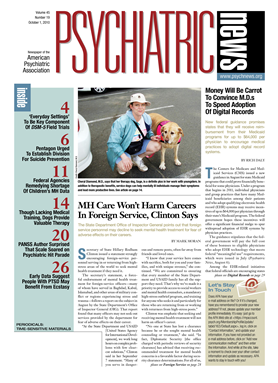Most criminal defendants who opt for jail-diversion programs do not feel coerced into participating, but a substantial minority does perceive pressure to enter the program or remain in treatment, according to a new study in the September Psychiatric Services.
The levels of perceived coercion “are actually no greater than those reported by voluntary psychiatric outpatients or participants in a mental health court,” noted Karen Cusack, Ph.D., Henry Steadman, Ph.D., and Amy Herring, Sc.D. The study was funded by the National Institute of Mental Health and the Substance Abuse and Mental Health Services Administration (SAMHSA).
“From the outside, jail-diversion programs seem like a win-win situation, but we wanted to see how the defendants viewed the process,” said Cusack in an interview with Psychiatric News.
Diversion programs give defendants and some convicted people the chance to avoid incarceration in exchange for agreeing to enter community-based treatment. The programs seek to improve mental health outcomes and lessen the chances of future criminal activity and arrest.
Participation is voluntary, wrote Cusack and colleagues. “However, jail diversion takes place within the criminal justice system, and it is the perception of coercion (that is, lack of choice or control) in the process of receiving treatment that is most important.”
The issue of coercion is crucial because people forced into treatment are unlikely to accept it and participate fully in the therapeutic process.
“People in the criminal justice system don't feel they have a lot of choice in what happens to them,” Cusack added.
The researchers began by interviewing 905 jail-diversion participants as they entered programs from 2003 to 2005. The programs were funded by SAMHSA at 13 sites in 11 states. The researchers were able to talk to 398 of the program participants at the one-year follow-up point.
About 52 percent of the participants were male, about 32 percent were African American, and 21 percent were Hispanic. About 30 percent were diagnosed with depression or anxiety, 27 percent with bipolar disorder, and 26 percent with a schizophrenia spectrum disorder.
Participants were asked in several ways whether they felt free to go into the programs or had control over their choice.
At baseline, 10 percent of the participants said they felt high levels of coercion to enter the programs, and 26 percent indicated they experienced moderate coercion. At the one-year follow-up, 27 percent said that they had felt a high level of coercion to choose diversion, and 18 percent a moderate level, as measured with the MacArthur Perceived Coercion Scale.
Several factors affected the perception of coercion.
Participants facing drug charges were half as likely to report high coercion as those facing minor charges such as misdemeanors. Alternatives to jail might look especially attractive to those facing drug charges, speculated the authors.
Past-year sexual-abuse victimization was associated with feeling higher levels of coercion—but only among people who said they were not involved in current substance abuse.
“[S]exual abuse may lead an individual to feel a lack of control and possibly greater sensitivity to coercion, but this is no longer true when the person engages in substance abuse (and possibly faces drug-related charges),” they wrote.
At the one-year mark, only higher baseline perceived coercion and longer time from arrest to diversion appeared to explain higher feelings of coercion.
Perceptions of coercion played no role in who made use of mental health services one year after diversion. People who were older, had more severe mental illness symptoms, or were victims of sexual abuse (but without a history of physical or current substance abuse) were more likely than others to use those services. However, a 56 percent attrition rate from baseline to the one-year follow-up evaluation led the authors to suggest caution about interpreting those results.
“A lot were lost to follow-up, and there's no way to know why,” said Cusack.
